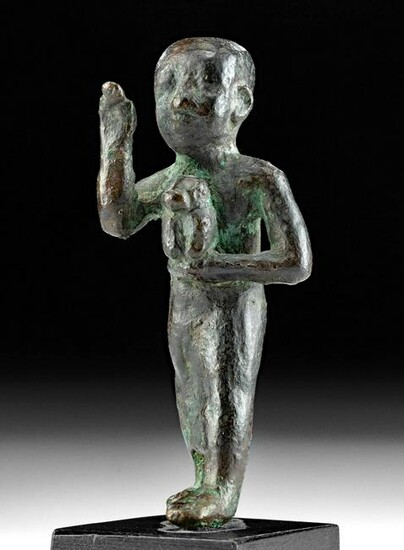Egyptian Bronze Striding Priest Holding a Baboon
Ancient Egypt, Saite Period, Twenty-Sixth Dynasty (XXVI), ca. 664 to 525 BCE. A very rare cast bronze figure of a standing priest, bald, wearing a long skirt/kilt, and raising one hand as if in blessing while holding a small baboon close to his chest with the other. Egypt had both male and female priests who were crucial to maintaining the complex religious rituals and beliefs of the Egyptian world. The power of the Egyptian priesthood served as a check on that of the monarchy, and high priests and the temples they commanded could amass wealth and influence that at times challenged the pharaoh. The figure depicted here in his simple attire is probably a "wab" priest, the lowest level of the priestly heirarchy, whose role was to care for the temple and perform minor functions like preparing for festivals. Size: 1.1" W x 2.45" H (2.8 cm x 6.2 cm); 3.2" H (8.1 cm) on included custom stand.
Baboons were worshiped by ancient Egyptians from the earliest times because of their practice of waking early and screeching, which priests interpreted as worship of the sun god as he rose. The animals came to represent Thoth, the god of writing, who gave the gift of language to the Egyptians. The famous frieze of baboons over the entrance to the Great Temple at Abu Simbel echoes through the ages to remind us of the importance of these animals to the ancient Egyptians. Egyptian temples often included animals who were cared for by priests, and the care with which the priest depicted here holds the baboon suggests a close, loving relationship between human and animal.
Provenance: private New York, USA collection, acquired 2014; ex-J.S. collection, Acton, Massachusetts, USA, 1990s
All items legal to buy/sell under U.S. Statute covering cultural patrimony Code 2600, CHAPTER 14, and are guaranteed to be as described or your money back.
A Certificate of Authenticity will accompany all winning bids.
PLEASE NOTE: Due to recent increases of shipments being seized by Australian & German customs (even for items with pre-UNESCO provenance), we will no longer ship most antiquities and ancient Chinese art to Australia & Germany. For categories of items that are acceptable to ship to Australia or Germany, please contact us directly or work with your local customs brokerage firm.
Display stands not described as included/custom in the item description are for photography purposes only and will not be included with the item upon shipping.
#126978
Condition Report: Smooth, dark, green-brown patina on surface. Very slight bending to feet. Nice preservation of detail, especially on the baboon.
View it on
Estimate
Time, Location
Auction House
Ancient Egypt, Saite Period, Twenty-Sixth Dynasty (XXVI), ca. 664 to 525 BCE. A very rare cast bronze figure of a standing priest, bald, wearing a long skirt/kilt, and raising one hand as if in blessing while holding a small baboon close to his chest with the other. Egypt had both male and female priests who were crucial to maintaining the complex religious rituals and beliefs of the Egyptian world. The power of the Egyptian priesthood served as a check on that of the monarchy, and high priests and the temples they commanded could amass wealth and influence that at times challenged the pharaoh. The figure depicted here in his simple attire is probably a "wab" priest, the lowest level of the priestly heirarchy, whose role was to care for the temple and perform minor functions like preparing for festivals. Size: 1.1" W x 2.45" H (2.8 cm x 6.2 cm); 3.2" H (8.1 cm) on included custom stand.
Baboons were worshiped by ancient Egyptians from the earliest times because of their practice of waking early and screeching, which priests interpreted as worship of the sun god as he rose. The animals came to represent Thoth, the god of writing, who gave the gift of language to the Egyptians. The famous frieze of baboons over the entrance to the Great Temple at Abu Simbel echoes through the ages to remind us of the importance of these animals to the ancient Egyptians. Egyptian temples often included animals who were cared for by priests, and the care with which the priest depicted here holds the baboon suggests a close, loving relationship between human and animal.
Provenance: private New York, USA collection, acquired 2014; ex-J.S. collection, Acton, Massachusetts, USA, 1990s
All items legal to buy/sell under U.S. Statute covering cultural patrimony Code 2600, CHAPTER 14, and are guaranteed to be as described or your money back.
A Certificate of Authenticity will accompany all winning bids.
PLEASE NOTE: Due to recent increases of shipments being seized by Australian & German customs (even for items with pre-UNESCO provenance), we will no longer ship most antiquities and ancient Chinese art to Australia & Germany. For categories of items that are acceptable to ship to Australia or Germany, please contact us directly or work with your local customs brokerage firm.
Display stands not described as included/custom in the item description are for photography purposes only and will not be included with the item upon shipping.
#126978
Condition Report: Smooth, dark, green-brown patina on surface. Very slight bending to feet. Nice preservation of detail, especially on the baboon.



